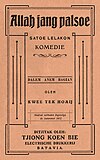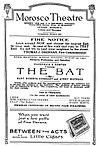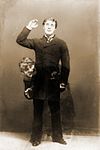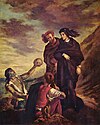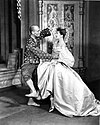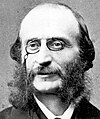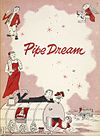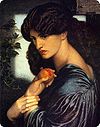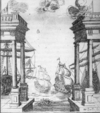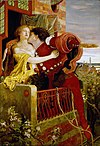Portal:Theatre/Featured article
Instructions
[edit]The layout design for these subpages is at Portal:Theatre/Selected article/Layout.
- Add a new selected article to the next available subpage.
- The list should only contain articles that have been given a quality rating of featured article; see Portal:Theatre/Featured content for some possibilities.
- Because the portal has a separate "Featured biography" list, the selections on this page should only include articles that are not biographies.
- The length of the "blurb" when previewed (including spaces) should be between 925 and 1025 characters, or slightly more when no free-use image can be included. (Fair use images are not allowed.) If the article has appeared previously as Today's Featured Article, the blurb written for that appearance is often a good place to start.
- Update "max=" to the new total for the "featured article" {{Random portal component}} at Portal:Theatre.
If you are unsure or do not know how to add an entry, feel free to post a question, suggestion or nomination at Portal talk:Theatre.
Selected articles list
[edit]Allah jang Palsoe (Malay for The False God) is a 1919 stage drama from the Dutch East Indies that was written by the ethnic Chinese author Kwee Tek Hoay, based on E. Phillips Oppenheim's short story "The False Gods". Over six acts, the Malay-language play follows two brothers, one a devout son who holds firmly to his morals and personal honour, the other a man who worships money and prioritises personal gain. The two learn over the course of a decade that money (the titular false god) is not the path to happiness. Kwee Tek Hoay's first stage play, Allah jang Palsoe was written as a realist response to whimsical contemporary theatre. Though the published stageplay sold poorly and the play was deemed difficult to perform, Allah jang Palsoe found success on the stage. By 1930 it had been performed by various ethnic Chinese troupes to popular acclaim, and had pioneered a body of work by authors such as Lauw Giok Lan, Tio Ie Soei, and Tjoa Tjien Mo. In 2006 the script for the play, which continues to be performed, was republished with updated spelling by the Lontar Foundation.
Allegro is a musical by Richard Rodgers (music) and Oscar Hammerstein II (book and lyrics), their third collaboration for the stage, which premiered on Broadway on October 10, 1947. After the immense successes of the first two Rodgers and Hammerstein musicals, Oklahoma! and Carousel, the pair sought a subject for their next play. Hammerstein had long contemplated a serious work that would deal with the problems of an ordinary man in the fast-moving modern world. Rodgers and he sought to create a work that would be as innovative as their first two stage musicals. To that end, they created a play with a large cast, including a Greek chorus. After a disastrous tryout in New Haven, Connecticut, the musical opened on Broadway to a large advance sale of tickets and very mixed reviews. The Broadway run, directed by Agnes de Mille, ended after nine months; it had no West End production and has rarely been revived.
The Author's Farce is a play by the English playwright and novelist Henry Fielding, first performed on 30 March 1730 at the Little Theatre, Haymarket. Written in response to the Theatre Royal's rejection of his earlier plays, The Author's Farce was Fielding's first theatrical success. The first and second acts deal with the attempts of the central character, Harry Luckless, to woo his landlady's daughter, and his efforts to make money by writing plays. In the second act, he finishes a puppet theatre play titled The Pleasures of the Town, about the Goddess Nonsense's choice of a husband from allegorical representatives of theatre and other literary genres. After its rejection by one theatre, Luckless's play is staged at another. The third act becomes a play within a play, in which the characters in the puppet play are portrayed by humans. The Author's Farce ends with a merging of the play's and the puppet show's realities. The play established Fielding as a popular London playwright, and the press reported that seats were in great demand. Although largely ignored by critics until the 20th century, most agree that the play is primarily a commentary on events in Fielding's life, signalling his transition from older forms of comedy to the new satire of his contemporaries.
The Bat is a three-act comedy-mystery play by Mary Roberts Rinehart and Avery Hopwood that was first produced by Lincoln Wagenhals and Collin Kemper. The play opened on Broadway on August 23, 1920. At a rented summer home, Cornelia Van Gorder and guests search for stolen money while being stalked by a masked criminal known as "the Bat". The play originated as an adaptation of Rinehart's 1908 mystery novel The Circular Staircase. It was a critical and commercial success, running for 867 performances in New York and 327 in London, with tours by several road companies. It was revived twice on Broadway, in 1937 and 1953. It had several adaptations, including a 1926 novelization credited to Rinehart and Hopwood but ghostwritten by Stephen Vincent Benét. Three film adaptations were produced: The Bat (1926), The Bat Whispers (1930), and The Bat (1959). The play and its adaptations inspired other comedy-mysteries with similar settings, and influenced the creation of the comic-book superhero Batman.
The Blue Flame is a four-act play written by George V. Hobart and John Willard, who revised an earlier version by Leta Vance Nicholson. In 1920, producer Albert H. Woods staged the play on Broadway and on tour across the United States. Ruth Gordon, the main character, is a religious young woman who dies and is revived by her scientist fiancé as a soulless femme fatale. She seduces several men and involves them in crimes, including drug use and murder. In the final act, her death and resurrection are revealed to be a dream. The production starred Theda Bara (pictured), a popular silent film actress who was known for playing similar roles in movies. Critics panned the play, ridiculing the plot, the dialog, and Bara's acting. Theater historian Ward Morehouse called it "one of the worst plays ever written". Bara's movie fame drew large crowds to theaters, and the play was a commercial success, breaking attendance records at some venues. Ruth Gordon was Bara's only Broadway role, and The Blue Flame was one of her last professional acting projects.
The Boydell Shakespeare Gallery was a three-part project initiated in November 1786 by engraver and publisher John Boydell in an effort to foster a school of British history painting. Boydell planned to focus on an illustrated edition of William Shakespeare's plays and a folio of prints, but during the 1790s the London gallery that showed the original paintings emerged as the project's most popular element. Boydell decided to publish a grand illustrated edition of Shakespeare's plays that would showcase the talents of British painters and engravers. He chose the noted scholar and Shakespeare editor George Steevens to oversee the edition, which was released between 1791 and 1803. The press reported weekly on the building of Boydell's gallery, designed by George Dance the Younger, on a site in Pall Mall. Boydell commissioned works from famous painters of the day, such as Joshua Reynolds, and the folio of engravings proved the enterprise's most lasting legacy. However, the long delay in publishing the prints and the illustrated edition prompted criticism. Because they were hurried, and many illustrations had to be done by lesser artists, the final products of Boydell's venture were judged to be disappointing. The project caused the Boydell firm to become insolvent, and they were forced to sell the gallery at a lottery.
Carousel (1945) is the second musical by the team of Richard Rodgers (music) and Oscar Hammerstein II (book and lyrics), after their hit Oklahoma! (1943). It was adapted from Ferenc Molnár's 1909 play Liliom, transplanting the setting to the U.S. state of Maine. Carousel barker Billy Bigelow's romance with millworker Julie Jordan cost them their jobs; after he attempts a robbery that goes tragically wrong, he is given a chance to make things right. The show includes the songs "If I Loved You", "June Is Bustin' Out All Over" and "You'll Never Walk Alone". It opened on Broadway on April 19, 1945, and was an immediate hit with both critics and audiences. It initially ran there for 890 performances, and duplicated its success in the West End in 1950. It has been repeatedly revived and recorded. A 1992 production by Nicholas Hytner enjoyed success in London, in New York, and on tour. Rodgers later wrote that Carousel was his favorite of all his musicals. In 1999, Time magazine named it the best musical of the 20th century.
The Country Wife is a Restoration comedy from 1675 by William Wycherley. A product of the tolerant early Restoration period, the play reflects an aristocratic and anti-Puritan ideology, and was controversial for its sexual explicitness even in its own time. Even its title contains a lewd pun. Based on several plays by Molière, it turns on two indelicate plot devices: a rake's trick of pretending impotence in order to safely have clandestine affairs with married women, and the arrival in London of an inexperienced young "country wife", with her discovery of the joys of town life, especially the fascinating London men. The scandalous trick and the frank language have for much of the play's history kept it off the stage and out of print. Between 1753 and 1924, The Country Wife was considered too outrageous to be performed at all and was replaced on the stage by David Garrick's cleaned-up and bland version The Country Girl. The original play is again a stage favourite today, and is also acclaimed by academic critics, who praise its linguistic energy, sharp social satire, and openness to different interpretations.
Creatures of Impulse is a short story by English dramatist W. S. Gilbert, which he later adapted for the stage with music by composer-conductor Alberto Randegger. Both the short story and the play concern an unwanted and ill-tempered old fairy who enchants people to behave in a manner opposite to their natures, with farcical results. The short story was written for The Graphic's Christmas number of 1870, and the play was first produced at the Court Theatre on 2 April 1871. It originally included six songs, but three were eventually cut, and some productions dispensed with the music entirely. While the lyrics survive, the music was never published and is lost. Reviews of the play were mostly positive, though it was criticised for the lack of a significant plot or superstructure to support its comic premise. Nonetheless, reviewers found it enjoyable, and it was a modest success, running for 91 performances and enjoying revivals into the early part of the 20th century. Gilbert had already written a considerable body of stories, plays, poems, criticism and other works before writing Creatures of Impulse and would go on to write the libretti to the famous Savoy operas (composed by Arthur Sullivan) between 1871 and 1896.
The Demi-Virgin is a three-act play written by Avery Hopwood (pictured). Producer Albert H. Woods staged it on Broadway, where it was one of the most successful plays of the 1921–22 season. The play is a bedroom farce about former couple Gloria Graham and Wally Deane, both movie actors, whose marriage was so brief that the press speculated about whether Gloria was still a virgin. Because it contained suggestive dialog and women in the cast wore revealing clothes, the production was considered highly risqué at the time. The script alluded to a contemporary scandal involving actor Fatty Arbuckle, and one scene featured actresses stripping as part of a card game. Reviewers generally panned the play as unfunny and vulgar. A magistrate ruled the play was obscene, and obscenity charges were brought against Woods, but a grand jury declined to indict him. Woods promoted the controversy to increase ticket sales. The play had no long-term literary impact and was never published, but it did stimulate arguments over censorship of theatrical performances.
Dr. Jekyll and Mr. Hyde is a four-act play written by Thomas Russell Sullivan in collaboration with the actor Richard Mansfield (pictured). It is an adaptation of Strange Case of Dr Jekyll and Mr Hyde, an 1886 novella by Robert Louis Stevenson. The story focuses on the respected London doctor Henry Jekyll, who uses a potion to transform into Edward Hyde, a loathsome criminal. Intrigued by the opportunity to play a dual role, Mansfield secured the stage rights and asked Sullivan to write the adaptation. The play debuted in Boston on May 9, 1887, then opened on Broadway in September of that year. Mansfield's performance as the dual character was acclaimed by critics. The play opened in London in August 1888, just before the first Jack the Ripper murders. Some press reports compared the murderer to the Jekyll-Hyde character, and Mansfield was suggested as a possible suspect. Mansfield's company continued to perform the play in the US until shortly before his death in 1907. Sullivan made changes from Stevenson's story that have been adopted by many subsequent adaptations, including several film versions that were derived from the play.
Flower Drum Song was the eighth stage musical by the team of Richard Rodgers and Oscar Hammerstein II (pictured). It was based on the 1957 novel, The Flower Drum Song, by Chinese-American author C. Y. Lee. Rodgers and Hammerstein had experienced back-to-back Broadway flops and hoped for a new commercial hit. Set in San Francisco's Chinatown, the story illustrates the conflict between the traditional older generation of immigrants and the younger generation, struggling to assimilate into American culture. The piece opened in 1958 on Broadway and was a success, afterwards being presented in the West End and on tour. It was subsequently made into a 1961 musical film. After the release of the film version, the musical was rarely produced, as it presented casting issues and fears that Asian-Americans would take offense at how they are portrayed. The piece did not return to Broadway until 2002, when a version with a plot by playwright David Henry Hwang was presented after a successful Los Angeles run. It received mostly poor reviews in New York and closed after six months, but had a short national tour and has since been produced regionally.
Hamlet is a tragedy by William Shakespeare, probably written between 1599 and 1601. Set in Denmark, the play tells how Prince Hamlet exacts revenge on his uncle for murdering the previous king, Hamlet's father. Hamlet's uncle has since stolen the throne and taken Hamlet's mother, the dead king's widow, as his wife. The play vividly charts the course of real and feigned madness—from overwhelming grief to seething rage—and explores themes of treachery, incest, and moral corruption. Despite much literary detective work, the exact year of writing remains in dispute. Three different early versions of the play survived, which are known as the First Quarto, the Second Quarto, and the First Folio. Each has lines, and even scenes, that are missing from the others. Shakespeare probably based Hamlet on an Indo-European legend—preserved by a 13th-century chronicler, and retold by a 16th-century scholar—and a lost Elizabethan play known today as the Ur-Hamlet. The play's dramatic structure and Shakespeare's depth of characterisation mean that Hamlet can be analysed and interpreted—and argued about—from many perspectives. Hamlet is by far Shakespeare's longest play, and among the most powerful and influential tragedies in the English language. The title role was almost certainly created for Richard Burbage, the leading tragedian of Shakespeare's time; in the four hundred years since, it has been played by the greatest actors, and sometimes actresses, of each successive age.
The Joan W. and Irving B. Harris Theater for Music and Dance is a 1499-seat theater for the performing arts located along the northern edge of Millennium Park in the Loop community area of Chicago. The theater was named for its primary benefactors, Joan and Irving Harris. It serves as the Park's indoor performing venue, a complement to Jay Pritzker Pavilion, which hosts the park's outdoor performances. Constructed in 2002–03, it is the city's premier performance venue for small- and medium-sized music and dance groups. It provides subsidized rental, technical expertise, and marketing support for the companies using it, and turned a profit in its fourth fiscal year. The Harris Theater has hosted notable national and international performers, such as the New York City Ballet's first visit to Chicago in over 25 years (in 2006). Performances have included the San Francisco Ballet, Mikhail Baryshnikov, and Stephen Sondheim. The theater has been credited as contributing to the performing arts renaissance in Chicago, and has been favorably reviewed for its acoustics, sightlines, proscenium and for providing a home for numerous performing organizations.
Her Majesty's Theatre is a West End theatre, located in the Haymarket, in the City of Westminster. The present building was designed by Charles J. Phipps and was constructed in 1897 for actor-manager Herbert Beerbohm Tree, who established the Royal Academy of Dramatic Art at the theatre. In the early decades of the 20th century, Tree produced spectacular productions of Shakespeare and other classical works, and the theatre hosted premières by major playwrights such as George Bernard Shaw, J. M. Synge, Noël Coward and J. B. Priestley. Since World War I, the wide flat stage has made the theatre suitable for large-scale musical productions, and the theatre has specialised in hosting musicals. The theatre has been home to record-setting musical theatre runs, notably the World War I sensation Chu Chin Chow and the current production, Andrew Lloyd Webber's The Phantom of the Opera, which has played continuously at Her Majesty's since 1986. The theatre's capacity is 1,216 seats, and the building was Grade II* listed by English Heritage in January 1970. Really Useful Group Theatres has owned the theatre since 2000.
The inaugural games of the Flavian Amphitheatre were held in 80 AD, on the orders of the Roman Emperor Titus, to celebrate the completion of the Colosseum, then known as the Flavian Amphitheatre. Vespasian began construction of the amphitheatre around 70 AD, and it was completed by Titus soon after Vespasian's death in 79 AD. After Titus' reign began with months of disasters, including the eruption of Mount Vesuvius, a fire in Rome, and an outbreak of plague, he inaugurated the building with lavish games which lasted for more than a hundred days, perhaps partially in an attempt to appease the Roman public and the gods. Little documentary evidence of the nature of the games remains. They appear to have followed the standard format of the Roman games: animal entertainments in the morning session, followed by the executions of criminals around midday, with the afternoon session reserved for gladiatorial combats and recreations of famous battles. Only three contemporary or near-contemporary accounts of the games survive. The works of Suetonius and Cassius Dio focus on major events, while Martial provides some fragments of information on individual entertainments and the only detailed record of a gladiatorial combat in the arena to survive to the present day: the fight between Verus and Priscus.
The King and I is a musical by the team of composer Richard Rodgers and dramatist Oscar Hammerstein II. It is based on the 1944 novel Anna and the King of Siam by Margaret Landon, which derives from the memoirs of Anna Leonowens, governess to the children of King Mongkut of Siam in the early 1860s. The musical relates the experiences of Anna, a British schoolteacher hired as part of the King's drive to modernize his country. Their relationship is marked by conflict through much of the piece, and a love that neither can admit. Rodgers and Hammerstein wrote the musical for veteran star Gertrude Lawrence. Rex Harrison, who played the King in the 1946 movie of Landon's book, was unavailable, so Yul Brynner was chosen. The musical premiered in March 1951 at Broadway's St. James Theatre and ran nearly three years. It was an immediate hit, winning Tony Awards for Best Musical and for Best Actress and Best Featured Actor for Lawrence and Brynner (pictured). A hit London run and U.S. national tour followed, together with a 1956 film for which Brynner won an Academy Award. Professional and amateur revivals of The King and I are staged regularly throughout the English-speaking world.
Me and Juliet is a musical comedy with music by Richard Rodgers and lyrics and book by Oscar Hammerstein II. The story deals with romance between the cast and crew backstage at a long-running musical, a show-within-the-show (also named Me and Juliet). The musical premiered in 1953 and ran for almost a year on Broadway, closing after it exhausted its advance sales. It received no Tony Award nominations. The play required complex machinery, designed by Jo Mielziner, so that the audience could view action not only on the stage but also in the wings and high above the stage near the spotlights. The show garnered less than favorable reviews, though Mielziner's staging won praise from audiences and critics. With the exception of a short run in Chicago, there was no national tour, and the show is rarely seen—although a small-scale production was presented by London's Finborough Theatre in 2010. "No Other Love" from the show became a hit record in 1953 for Perry Como and in 1956 for Ronnie Hilton.
Night of January 16th is a play by Russian-American author Ayn Rand, inspired by the death of Ivar Kreuger, an industrialist and accused swindler known as the Match King. The play is set in a courtroom during a murder trial, and members of the audience are chosen to play the jury. The court hears the case of Karen Andre, a former secretary and lover of businessman Bjorn Faulkner, of whose murder she is accused. The jury must rely on character testimony to decide whether Andre is guilty; the play's ending depends on their verdict. Rand wanted to dramatize a conflict between individualism and conformity. The play was first produced in 1934 in Los Angeles under the title Woman on Trial. Producer Al Woods took it to Broadway for the 1935–36 season and re-titled it Night of January 16th. It became a hit and ran for seven months. The play has been adapted as a movie, as well as for television and radio. Rand had many disputes with Woods over the play, and in 1968 re-edited it for publication as her "definitive" version.
Orpheus in the Underworld (Orphée aux enfers, 1858) is a comic opera with music by Jacques Offenbach (pictured) and words by Hector Crémieux and Ludovic Halévy. It was extensively revised and expanded in 1874 for a run that broke box-office records at the Théâtre de la Gaîté, Paris. In the opera, a lampoon of the legend of Orpheus and Eurydice, Orpheus is a rustic violin teacher who is glad to be rid of his wife when she is abducted by the god of the underworld. The reprehensible conduct of the gods of Olympus was widely seen as a veiled satire of the court and government of Napoleon III, Emperor of the French. Some critics expressed outrage at the librettists' disrespect for classic mythology and the composer's parody of Gluck's opera Orfeo ed Euridice; others praised the piece highly. It was Offenbach's first full-length opera and remains the one that is most often performed. Can-can cabaret acts still use its "Galop infernal", adopted later in the 19th century by the Moulin Rouge and Folies Bergère.
Peking opera (also called Beijing opera) is a form of traditional Chinese theatre which combines music, vocal performance, mime, dance, and acrobatics. It arose in the late 18th century and became fully developed and recognized by the mid-19th century. The form was extremely popular in the Qing dynasty court and has come to be regarded as one of the cultural treasures of China. Major performance troupes are based in Beijing and Tianjin in the north, and Shanghai in the south. The art form is also enjoyed in Taiwan, and has spread to other countries such as the United States and Japan. Beijing opera features four main types of performers. Performing troupes often have several of each variety, as well as numerous secondary and tertiary performers. With their elaborate and colorful costumes, performers are the only focal points on Beijing opera's characteristically sparse stage. They utilize the skills of speech, song, dance, and combat in movements that are symbolic and suggestive, rather than realistic. Above all else, the skill of performers is evaluated according to the beauty of their movements.
Pipe Dream is the seventh musical by the team of Richard Rodgers and Oscar Hammerstein II. Premiering on Broadway on November 30, 1955, it was a flop and a financial disaster. It is based on John Steinbeck's short novel Sweet Thursday, which he wrote in the hope of having it adapted into a musical. Set in Monterey, California, the musical tells the story of the romance between Doc, a marine biologist, and Suzy, who in the novel is a prostitute; her profession is only alluded to in the stage work. Rodgers and Hammerstein signed operatic diva Helen Traubel to play Fauna, the house madam. They had concerns about featuring a prostitute as female lead and setting part of the musical in a bordello and as the show progressed through tryouts, Hammerstein repeatedly revised it, obscuring Suzy's profession and the nature of Fauna's house. Pipe Dream met with poor reviews, and rapidly closed once it exhausted its advance sale. It had no national tour or London production, and has rarely been presented since. There was no film at the time; the Rodgers & Hammerstein Organization once hoped for a film version featuring the Muppets with Fauna played by Miss Piggy.
Proserpine is a verse drama written for children by the Romantic writers Mary Shelley and Percy Bysshe Shelley. Mary wrote the blank verse drama and Percy contributed two lyric poems. Composed in 1820 while the Shelleys were living in Italy, it is often considered a partner to the Shelleys' play Midas. Proserpine was first published in the London periodical The Winter's Wreath in 1832. The drama is based on Ovid's tale of the abduction of Proserpine by Pluto, which itself was based on the Greek myth of Demeter and Persephone. Mary Shelley's version focuses on the female characters. In a largely feminist retelling from Ceres's point of view, Shelley emphasises the separation of mother and daughter and the strength offered by a community of women. Ceres represents life and love, and Pluto represents death and violence. The genres of the text also reflect gender debates of the time. Proserpine is part of a female literary tradition which, as feminist literary critic Susan Gubar describes it, has used the story of Ceres and Proserpine to "re-define, to re-affirm and to celebrate female consciousness itself". However, the play has been both neglected and marginalised by critics.
The Relapse is a Restoration comedy from 1696 by John Vanbrugh, a sequel to Colley Cibber's notorious tear-jerker Love's Last Shift, or, Virtue Rewarded. In Cibber's Love's Last Shift, a free-living Restoration rake is brought to repentance and reform by the ruses of his wife, while in The Relapse, the rake succumbs again to temptation and has a new love affair. His virtuous wife is also subjected to a determined seduction attempt, and resists with difficulty. Vanbrugh planned The Relapse around particular actors at Drury Lane, writing their stage habits, public reputations, and personal relationships into the text. One such actor was Colley Cibber himself, who played the luxuriant fop Lord Foppington in both Love's Last Shift and The Relapse. However, Vanbrugh's artistic plans were threatened by a cut-throat struggle between London's two theatre companies, each of which was "seducing" actors from the other. The Relapse came close to not being produced at all, but the successful performance that was eventually achieved in November 1696 vindicated Vanbrugh's intentions, as well as saving the company from bankruptcy.
The Restoration spectacular, or elaborately staged "machine play", hit the London public stage in the late 17th-century Restoration period, enthralling audiences with action, music, dance, moveable scenery, baroque illusionistic painting, gorgeous costumes, and special effects such as trapdoor tricks, "flying" actors, and fireworks. These shows have always had a bad reputation as a vulgar and commercial threat to the witty, "legitimate" Restoration drama; however, they drew Londoners in unprecedented numbers and left them dazzled and delighted. Basically home-grown and with roots in the early 17th-century court masque, though never ashamed of borrowing ideas and stage technology from French opera, the spectaculars are sometimes called "English opera". The expense of mounting ever more elaborate scenic productions drove the two competing theatre companies into a dangerous spiral of huge expenditure and correspondingly huge losses or profits.
The Rite of Spring is a ballet and orchestral concert work by the Russian composer Igor Stravinsky. It was written for the 1913 Paris season of Sergei Diaghilev's Ballets Russes company, with choreography by Vaslav Nijinsky and stage designs and costumes by Nicholas Roerich (pictured). The ballet caused a near-riot in the audience when first performed, on 29 May 1913 at the Théâtre des Champs-Élysées in Paris, but rapidly achieved success as a concert piece and later became recognised as one of the most influential musical works of the 20th century. The score has many novel features, including experiments in tonality, metre, rhythm, stress and dissonance. The scenario is the celebration of spring by various primitive rituals, at the end of which a sacrificial victim dances herself to death. After its explosive premiere the ballet was not performed until the 1920s, when Léonide Massine's rechoreographed version was the first of many innovative productions directed by the world's leading ballet-masters. Providing "endless stimulation for performers and listeners" alike, The Rite is among the most recorded works in the classical repertoire.
Romeo and Juliet is a tragedy written early in the career of playwright William Shakespeare about two teenage "star-cross'd lovers" whose untimely deaths ultimately unite their feuding families. It was among Shakespeare's most popular plays during his lifetime and, along with Hamlet, is one of his most frequently performed plays. Its plot is based on an Italian tale, translated into verse as The Tragical History of Romeus and Juliet by Arthur Brooke in 1562, and retold in prose in Palace of Pleasure by William Painter in 1582. Shakespeare borrowed heavily from both, but developed supporting characters, particularly Mercutio and Paris, in order to expand the plot. Believed to be written between 1591 and 1595, the play was first published in a quarto version in 1597. The play ascribes different poetic forms to different characters, sometimes changing the form as the character develops. John Gielgud's 1935 version kept very close to Shakespeare's text, and used Elizabethan costumes and staging to enhance the drama. In the 20th century the play has been adapted in versions as diverse as MGM's comparatively faithful 1936 film, the 1950s stage musical West Side Story, and 1996's MTV-inspired Romeo + Juliet.
The Shakespeare authorship question is the argument, first raised in the 19th century, that someone other than William Shakespeare of Stratford-upon-Avon wrote the works attributed to him. All but a few Shakespeare scholars and literary historians consider it a fringe belief. Anti-Stratfordians believe that Shakespeare was a front to shield the identity of the real author or authors, who for some reason did not want or could not accept public credit. The controversy has spawned a vast body of literature, and more than 80 authorship candidates have been proposed, the most popular being Francis Bacon (pictured), Edward de Vere, Christopher Marlowe, and William Stanley. To the claim that Shakespeare lacked sufficient education, aristocratic sensibility, or familiarity with the royal court for a writer of such eminence and genius, scholars reply that there is much documentary evidence supporting his authorship—title pages, testimony by contemporary poets and historians, official records—and none supporting any other candidate.
The Theatre Royal, Drury Lane is a theatre in the Covent Garden district of London, facing Catherine Street and backing onto Drury Lane. The building standing today is the most recent in a line of four theatres at the same location dating back to 1663. For its first two centuries, Drury Lane could "reasonably have claimed to be London's leading theatre" and thus one of the most important theatres in the English-speaking world. Through most of that time, it was one of a small handful of patent theatres that were granted monopoly rights to the production of "legitimate" drama in London. The first theatre on the location was built on behest of Thomas Killigrew in the early years of the English Restoration. The building that stands today opened in 1812. It has been home to actors as diverse as Shakespearean Edmund Kean, comedian Dan Leno, and musical composer and performer Ivor Novello. Today, the theatre is owned by composer Andrew Lloyd Webber and generally stages popular musical theatre. It is a Grade I listed building.
Thespis is an operatic extravaganza that was the first collaboration between dramatist W. S. Gilbert and composer Arthur Sullivan. It was never published, and most of the music is now lost. However, Gilbert and Sullivan went on to become one of the most famous and successful partnerships in Victorian England, creating a string of comic opera hits, including H.M.S. Pinafore, The Pirates of Penzance and The Mikado, that continue to be popular. Thespis premièred in London at the Gaiety Theatre on 26 December 1871. Like many productions at that theatre, it was written in a broad, burlesque style, considerably different from Gilbert and Sullivan's later works. It was a modest success—for a Christmas entertainment of the time—and closed on 8 March 1872, after a run of 63 performances. It was advertised as "An entirely original Grotesque Opera in Two Acts". The story follows an acting troupe headed by Thespis, the legendary Greek father of the drama, who temporarily trade places with the gods on Mount Olympus, who have grown elderly and ignored. The actors turn out to be comically inept rulers. Having seen the ensuing mayhem down below, the angry gods return, sending the actors back to Earth as "eminent tragedians, whom no one ever goes to see".
Trial by Jury is a comic opera in one act, with music by Arthur Sullivan and libretto by W. S. Gilbert. It was first produced on 25 March 1875, at London's Royalty Theatre, where it initially ran for 131 performances and was considered a hit, receiving critical praise and outrunning its popular companion piece, Jacques Offenbach's La Périchole. The story concerns a "breach of promise of marriage" lawsuit in which the judge and legal system are the objects of lighthearted satire. Gilbert based the libretto of Trial by Jury on an operetta parody that he had written in 1868. The opera premiered more than three years after Gilbert and Sullivan's only previous collaboration, Thespis, an 1871–72 Christmas season entertainment. In the intervening years, both the author and composer were busy with separate projects. Beginning in 1873, Gilbert tried several times to get the opera produced before the impresario Richard D'Oyly Carte suggested that he collaborate on it with Sullivan. Sullivan was pleased with the piece and promptly wrote the music. Critics and audiences praised how well Sullivan's witty and good-humoured music complemented Gilbert's satire. The success of Trial by Jury launched the famous series of 13 collaborative works between Gilbert and Sullivan that came to be known as the Savoy Operas.
The Unconquered is a three-act play written by Russian-American author Ayn Rand as an adaptation of her 1936 novel We the Living. Producer George Abbott staged the play on Broadway in February 1940, featuring Helen Craig (pictured) as Kira Argounova, a young woman living in the Soviet Union in the 1920s. Her lover Leo Kovalensky develops tuberculosis. To get money for his treatment, Kira has an affair with a Communist official, Andrei Taganov. After Leo recovers from his illness, he becomes involved with black market food sales that Andrei is investigating. When Andrei realizes that Kira loves Leo, he helps his rival avoid prosecution, then commits suicide. Leo leaves Kira, who decides to risk her life escaping the country. The production was troubled by problems with the script and the cast. When the play opened at the Biltmore Theatre, it was a critical and financial failure, and closed in less than a week. It was the last of Rand's plays produced during her lifetime.
A Very Merry Unauthorized Children's Scientology Pageant is a satirical musical about Scientology and L. Ron Hubbard, written by Kyle Jarrow from a concept by Alex Timbers, the show's original director. The one-act musical lasts about an hour. Jarrow based the story of the musical on L. Ron Hubbard's writings and Church of Scientology literature. The musical follows the life of L. Ron Hubbard as he develops Dianetics and then Scientology. Though the musical pokes fun at Hubbard's science fiction writing and personal beliefs, it has been called a "deadpan presentation" of his life story. Topics explored in the piece include Dianetics, the E-meter, Thetans, and the story of Xenu. The show was originally presented by Les Freres Corbusier, an experimental theatrical troupe and debuted in November 2003 in New York City, where it had sold-out Off-Off-Broadway and Off-Broadway productions. Later performances have included Los Angeles, New York, Boston, Atlanta and Philadelphia. Productions of A Very Merry Unauthorized Children's Scientology Pageant in 2003, 2004 and 2006 were well received. The musical received an Obie Award for the 2003 New York production, and director Alex Timbers received a Garland Award for the 2004 Los Angeles production. The play also received positive reviews in the press.

